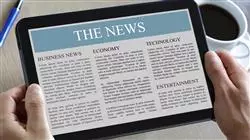University certificate
The world's largest faculty of journalism and communication”
Introduction to the Program
After studying this Advanced master’s degree, you will be a highly-sought-after professional, capable of managing business communication in a company"

Successfully and effectively managing corporate communication is essential for the survival of any company, since it is the department responsible for maintaining the company's reputation through the implementation of communication strategies, and protecting the business from possible smear campaigns. But also, it is responsible for creating a corporate image that is easily recognized by the general public, through which the work done by the company is recognized.
Similarly, the advance of new technologies has led this department to gain relevance in recent years, since, at present, the company-customer relationship has moved to the digital world, particularly on social networks, where a great deal of the communication between the two is carried out. Therefore, it is essential that communication managers are highly-skilled in the use of these tools and are able to use them for the benefit of the company's image. For this reason, at TECH we have designed this very complete Advanced master’s degree with which the student will be able to acquire the skills required to develop in this field.
With this program, we will not only take you through the theoretical knowledge we offer, but we will show you another way of studying and learning which is more organic, simpler and more efficient. We will work to keep you motivated and to create in you a passion for learning. We will also push you to think and develop your critical thinking skills.
This Advanced master’s degree is designed to give you access to the key information related to this discipline in an intensive and practical way which will be of great value for any professional. And it takes place in a 100% online format, allowing you to decide where and when to study. Without the restrictions of fixed timetables or having to move between classrooms, this course can be combined with work and family life.
A high-level specialization, supported by advanced technological development and the teaching experience of the best professionals"
This Advanced master’s degree in Communications and Corporate Identity Management contains the most complete and up-to-date academic program on the university scene. The most important features of the program include:
- The latest technology in online teaching software
- A highly visual teaching system, supported by graphic and schematic contents that are easy to assimilate and understand
- Practical cases presented by practising experts
- State-of-the-art interactive video systems
- Teaching supported by remote training
- Continuous updating and retraining systems
- Self-organized learning which makes the course completely compatible with other commitments
- Practical exercises for self-evaluation and learning verification
- Support groups and educational synergies: questions to the expert, debate and knowledge forums
- Content that is accessible from any, fixed or portable device with an Internet connection
- Complementary resource banks that are permanently available
A program created for professionals who aspire to excellence that will allow you to acquire new skills and strategies in a smooth and effective way"
Our teaching staff is made up of working professionals. In this way we ensure that we provide you with the up-to-date knowledge we are aiming for. A multidisciplinary team of professionals trained and experienced in different environments, who will develop theoretical knowledge efficiently, but, above all, will invest in the specialization the practical knowledge derived from their own experience.
Developed by a multidisciplinary team of e-learning experts, this Advanced master’s degree integrates the latest advances in educational technology. This way you will be able to study with a range of easy-to-use and versatile multimedia tools that will give you the skills you need for your specialization.
The design of this program is based on Problem-Based Learning, an approach that conceives learning as a highly practical process. To achieve this remotely, we will use online learning. With the help of an innovative interactive video system and Learning from an Expert, you will be able to acquire the knowledge as if you were actually dealing with the case you are studying. A concept that will allow you to integrate and consolidate your learning in a more realistic and permanent way.
Specializing in Business Communication will help your CV stand out from the rest"

We have the best teaching methodology and a multitude of simulated cases that will help you learn in real situations"
Why study at TECH?
TECH is the world’s largest online university. With an impressive catalog of more than 14,000 university programs available in 11 languages, it is positioned as a leader in employability, with a 99% job placement rate. In addition, it relies on an enormous faculty of more than 6,000 professors of the highest international renown.

Study at the world's largest online university and guarantee your professional success. The future starts at TECH”
The world’s best online university according to FORBES
The prestigious Forbes magazine, specialized in business and finance, has highlighted TECH as “the world's best online university” This is what they have recently stated in an article in their digital edition in which they echo the success story of this institution, “thanks to the academic offer it provides, the selection of its teaching staff, and an innovative learning method aimed at educating the professionals of the future”
A revolutionary study method, a cutting-edge faculty and a practical focus: the key to TECH's success.
The most complete study plans on the university scene
TECH offers the most complete study plans on the university scene, with syllabuses that cover fundamental concepts and, at the same time, the main scientific advances in their specific scientific areas. In addition, these programs are continuously being updated to guarantee students the academic vanguard and the most in-demand professional skills. In this way, the university's qualifications provide its graduates with a significant advantage to propel their careers to success.
TECH offers the most comprehensive and intensive study plans on the current university scene.
A world-class teaching staff
TECH's teaching staff is made up of more than 6,000 professors with the highest international recognition. Professors, researchers and top executives of multinational companies, including Isaiah Covington, performance coach of the Boston Celtics; Magda Romanska, principal investigator at Harvard MetaLAB; Ignacio Wistumba, chairman of the department of translational molecular pathology at MD Anderson Cancer Center; and D.W. Pine, creative director of TIME magazine, among others.
Internationally renowned experts, specialized in different branches of Health, Technology, Communication and Business, form part of the TECH faculty.
A unique learning method
TECH is the first university to use Relearning in all its programs. It is the best online learning methodology, accredited with international teaching quality certifications, provided by prestigious educational agencies. In addition, this disruptive educational model is complemented with the “Case Method”, thereby setting up a unique online teaching strategy. Innovative teaching resources are also implemented, including detailed videos, infographics and interactive summaries.
TECH combines Relearning and the Case Method in all its university programs to guarantee excellent theoretical and practical learning, studying whenever and wherever you want.
The world's largest online university
TECH is the world’s largest online university. We are the largest educational institution, with the best and widest online educational catalog, one hundred percent online and covering the vast majority of areas of knowledge. We offer a large selection of our own degrees and accredited online undergraduate and postgraduate degrees. In total, more than 14,000 university degrees, in eleven different languages, make us the largest educational largest in the world.
TECH has the world's most extensive catalog of academic and official programs, available in more than 11 languages.
Google Premier Partner
The American technology giant has awarded TECH the Google Google Premier Partner badge. This award, which is only available to 3% of the world's companies, highlights the efficient, flexible and tailored experience that this university provides to students. The recognition as a Google Premier Partner not only accredits the maximum rigor, performance and investment in TECH's digital infrastructures, but also places this university as one of the world's leading technology companies.
Google has positioned TECH in the top 3% of the world's most important technology companies by awarding it its Google Premier Partner badge.
The official online university of the NBA
TECH is the official online university of the NBA. Thanks to our agreement with the biggest league in basketball, we offer our students exclusive university programs, as well as a wide variety of educational resources focused on the business of the league and other areas of the sports industry. Each program is made up of a uniquely designed syllabus and features exceptional guest hosts: professionals with a distinguished sports background who will offer their expertise on the most relevant topics.
TECH has been selected by the NBA, the world's top basketball league, as its official online university.
The top-rated university by its students
Students have positioned TECH as the world's top-rated university on the main review websites, with a highest rating of 4.9 out of 5, obtained from more than 1,000 reviews. These results consolidate TECH as the benchmark university institution at an international level, reflecting the excellence and positive impact of its educational model.” reflecting the excellence and positive impact of its educational model.”
TECH is the world’s top-rated university by its students.
Leaders in employability
TECH has managed to become the leading university in employability. 99% of its students obtain jobs in the academic field they have studied, within one year of completing any of the university's programs. A similar number achieve immediate career enhancement. All this thanks to a study methodology that bases its effectiveness on the acquisition of practical skills, which are absolutely necessary for professional development.
99% of TECH graduates find a job within a year of completing their studies.
Advanced Master's Degree in Communication and Corporate Identity Management
.
In recent years, large companies have increasingly required the services of specialized professionals to establish communication links with the public, which has highlighted the growing window of opportunity in this area. At TECH Global University we have developed the Advanced Master's Degree in Communication and Corporate Identity Management, a program designed with the purpose of expanding your knowledge in the latest techniques, technologies and trends, both informative and communicative, which require the correct development of specific functions in this field. From this, you will manage to stand out as an expert in this discipline and revalue your professional profile.
Specialize the largest Faculty of Journalism and Communication
.
If you want to participate in the implementation of campaigns, strategies and projects of dissemination and identity creation that are effective for the growth, evolution and success of any company, our Advanced Master's Degree is for you. You will understand the basic concepts and theoretical models of human communication, its elements and characteristics, and you will apply them skillfully to the different contexts, media and systems in which communication projects are based; you will master the forms and processes of advertising languages, and you will be able to optimize the use of new ways and communication strategies of digital media. In other words, you will acquire the necessary knowledge to carry out an adequate advertising communication using the most advanced digital tools. get certified now!







